Summary of the Day:
Valdai Discussion Club Director Lukyanov downplayed territorial concerns in Ukraine while emphasizing NATO expansion as the war’s “root cause,” suggesting the Kremlin expects to leverage perceived weaknesses in a potential Trump administration. Meanwhile, the Parliamentary Assembly of the Council of Europe (PACE) adopted a resolution supporting Ukraine’s “peace through strength” position, emphasizing that sustainable peace can only be achieved through Ukrainian military strength.
The US military has transferred approximately 90 decommissioned Patriot missiles from storage facilities in Israel to Poland, with plans to deliver them to Ukraine. Simultaneously, an investigation revealed that Chinese companies continue supplying Russia with critical war materials including gallium, germanium, and antimony – key elements used in Russian drones and missiles.
Ukrainian forces have regained previously lost positions near Kharkiv and Pokrovsk. Russian forces, however, made advances near Chasiv Yar, Toretsk, and Kurakhove, as well as in the Dnipro direction.
Picture of the Day:
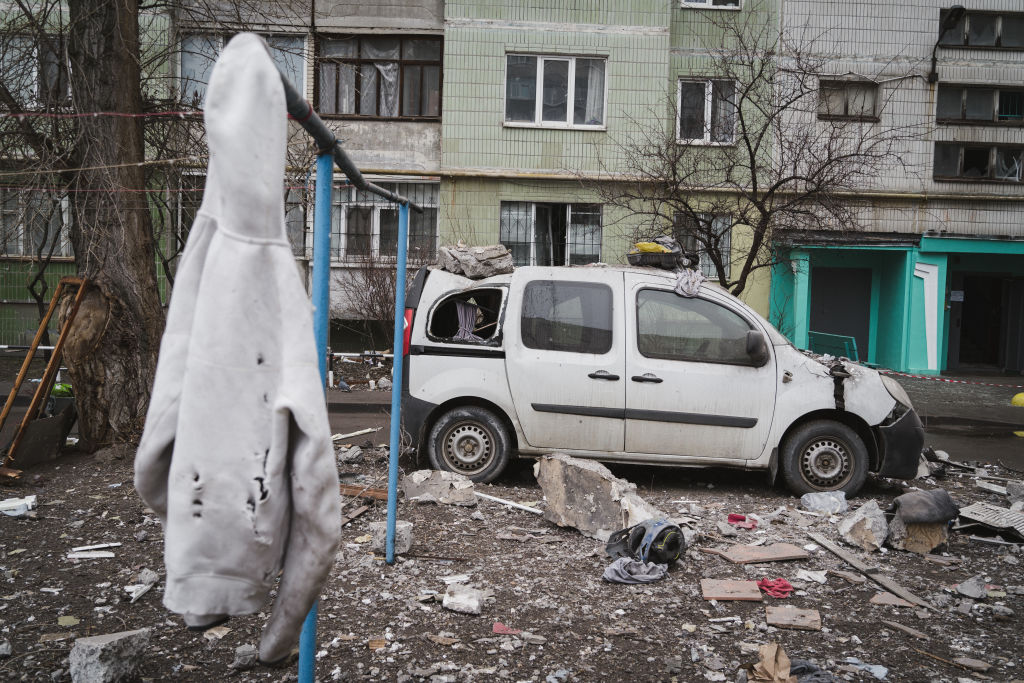 A damaged car lies in the yard of a damaged residential building after a Russian drone attack against Sumy. The attack killed nine people and injured 13, including an 8-year-old child. Rescuers evacuated over 100 people from the damaged building. (Kateryna Anokhina/ Cukr.city/Global Images Ukraine via Getty Images)
A damaged car lies in the yard of a damaged residential building after a Russian drone attack against Sumy. The attack killed nine people and injured 13, including an 8-year-old child. Rescuers evacuated over 100 people from the damaged building. (Kateryna Anokhina/ Cukr.city/Global Images Ukraine via Getty Images)
Beyond Ukraine – The March Towards World War
The Collective Security Treaty Organization (CSTO) has approved its 2025 military exercise schedule, with joint training events planned across Belarus, Kyrgyzstan, and Tajikistan. Notable exercises include counter-terrorism training in Tajikistan, which appears to be a response to the March 2024 Crocus City Hall terrorist attack in Moscow by Islamic State Khorasan Province-affiliated Tajik nationals. These coordinated military exercises among CSTO member states signal increased military cooperation and counter-terrorism focus in the region, potentially impacting regional security dynamics.
Romanian presidential frontrunner Calin Georgescu, who gained prominence on TikTok and leads polls with 38% support for the May 2024 election, sparked diplomatic tension by calling Ukraine a “fictional state” and predicting its inevitable partition. He suggested Romania could acquire regions like Northern Bukovina, Budjak, and Northern Marmarosh after the war, while Poland might control Lviv and Russia the eastern regions. The controversy follows Romania’s Constitutional Court annulling previous election results after intelligence reports revealed “aggressive Russian hybrid actions.” Georgescu, who has expressed admiration for Vladimir Putin and opposes Romanian military aid to Ukraine, also claimed a potential Trump-Putin deal could affect Romania’s commitments to Ukraine, raising concerns about Russian influence in European politics.
Ukraine’s Foreign Ministry condemned Georgescu’s statements as Russian propaganda but expressed confidence in Romania’s continued support for peace, highlighting the significance of their relationship as Romania has been a key ally providing military aid and supporting grain transit. His statements, alongside similar rhetoric from other far-right Romanian politicians, raise concerns about regional stability, particularly given Romania’s strategic position as both a NATO member and Ukraine’s neighbor.
The Path to Peace
Valdai Discussion Club Research Director Fyodor Lukyanov discussed potential negotiations between Russian President Putin and US President Trump. The interview, titled “Don’t count on big agreements,” appears aimed at managing expectations about future peace talks. While Lukyanov has no official government role, he is a prominent figure who regularly moderates Putin’s speeches at Valdai, an international forum used by the Kremlin to influence Western policy. His statements align with previous positions expressed by Putin and other Russian officials regarding potential negotiations.
Lukyanov emphasized that future Ukraine peace talks should focus on addressing what he called the “root causes” of the conflict – NATO’s eastward expansion in the 1990s and 2000s – rather than territorial issues. He stated bluntly that regarding territory, “how much you take is yours,” suggesting Russia won’t compromise on its territorial gains. The Kremlin appears to want the US to recognize Russia’s territorial claims before beginning negotiations about broader security changes in Eastern Europe, including potential changes to NATO’s structure and military presence in the region.
In December 2024, Russian Foreign Minister Lavrov characterized NATO’s eastward expansion and “aggressive absorption” of areas near Russia as key issues to address in peace talks. These demands echo Putin’s December 2021 pre-invasion requirements, which included preventing Ukraine from joining NATO and restricting NATO’s activities in Eastern Europe, the South Caucasus, and Central Asia. A January 10 Financial Times report, citing sources close to Putin, indicates he maintains these demands. Lukyanov’s recent statements reinforce that the Kremlin remains firm in its position to impose its security interests on the US and Europe without compromise.
Lukyanov suggested Trump’s administration would be more vulnerable to Kremlin pressure than Biden’s. He portrayed Trump as dismissive of European allies and NATO, claiming Trump might compromise NATO’s core principles to meet Putin’s demands for withdrawal from Eastern Europe. Lukyanov advised the Kremlin to maintain a tough stance in negotiations, even suggesting the use of bluffing, stating “Trump only respects those who show steadfastness.” The interview appears to support the Kremlin’s strategy to pressure Trump into accepting demands for Ukraine’s surrender and NATO’s weakening, while positioning Putin as Trump’s equal internationally.
The Parliamentary Assembly of the Council of Europe (PACE) adopted a resolution supporting Ukraine’s position that peace can only be achieved through military strength. The resolution called for continued European support and stated that peace negotiations must include Ukraine directly and require Russia to abandon its imperial goals. PACE condemned Russia’s violations of Ukrainian sovereignty and praised Ukraine’s progress toward EU membership. This aligns with President Zelensky’s previous statements that just peace requires enhanced military support for Ukraine, given Russia’s unwillingness to negotiate in good faith.
In a controversial proposal, some EU officials, particularly from Hungary and Germany, are considering resuming Russian pipeline gas purchases as part of a potential peace settlement with Russia, according to the Financial Times. This comes after Ukraine recently stopped Russian gas transit through its territory, prompting protests from EU members like Slovakia and Hungary who still depend on Russian supplies. The proposal faces opposition from Ukraine’s key EU allies and eastern member states. While pipeline gas imports have largely stopped, Europe continues to buy Russian LNG, with TurkStream remaining the only operational pipeline to the EU. The EU aims to eliminate all Russian fossil fuel imports by 2027, having already significantly reduced coal, oil, and gas purchases from Russia.
PACE (Parliamentary Assembly of the Council of Europe) refused to register an amendment that would label Russian President Vladimir Putin a terrorist in its resolution on peace in Ukraine. The amendment, proposed by Ukrainian lawmakers and a Swedish MP, was rejected because PACE’s table office claimed calling Putin a terrorist would “insult his dignity.” Ukrainian lawmaker Oleksandr Merezhko disputed this decision, arguing that “terrorist” is a legal term, not an insult, and noted that PACE had previously recognized Russia as a “terrorist regime.” The final resolution instead referred to “Putin’s totalitarian regime” and emphasized that peace requires Russia to abandon its imperial ambitions.
Lithuanian Armed Forces Commander Raimundas Vaiksnoras said Lithuania would likely consider sending peacekeepers to Ukraine if a ceasefire is reached. This follows discussions among Western nations about potential peacekeeping missions, with Germany and the UK also considering participation. The topic emerged amid reports that Trump’s team is considering a plan to delay Ukraine’s NATO membership in exchange for continued Western support and European peacekeepers. While Russia opposes the idea, warning of potential escalation, both Ukraine’s Zelensky and Russia’s Putin have indicated openness to peace talks with Trump as mediator.
Situation On The Land, Sea, and Air in Ukraine
Russian forces reportedly advanced into northern Sumy Oblast, Ukraine, near the village of Zhuravka along the Russia-Ukraine border. While a Russian military blogger claims Russian troops moved into Zhuravka and nearby fields as part of efforts to eliminate a Ukrainian position in Kursk Oblast, these claims remain unconfirmed.
Russia is strengthening defenses at its Millerovo air base near the Ukrainian border by installing new S-300/400 air defense systems and building aircraft shelters. The base, home to Russia’s 31st Fighter Aviation Regiment with Su-30SM and Su-35 fighters, is crucial for supporting Russian operations in eastern and southern Ukraine. Similar protective measures are being implemented at other Russian bases including Belbek in occupied Crimea and Primorsko-Akhtarsk in Krasnodar Krai, reportedly in response to Ukraine’s enhanced long-range strike capabilities. On December 23, Ukraine launched a drone attack on Millerovo, with Russia claiming to have intercepted eight drones near the airfield.
Russian-appointed Zaporizhia official Vladimir Rogov claimed that Russian forces shot down five Ukrainian drones near occupied Berdyansk.
Ukraine’s Special Operations Forces (SSO) conducted two significant operations against Russian positions. In the first operation, SSO’s 3rd Regiment dropped 13 kg of plastic explosives into a Russian dugout, reportedly killing four Russian soldiers. In a separate operation, the same regiment reclaimed previously lost Ukrainian positions, eliminating several Russian soldiers and capturing one prisoner named Alexey. Both operations demonstrated tactical precision, with SSO forces using armored vehicles, reconnaissance, and coordinated fire support to achieve their objectives. The exact locations of these operations were not disclosed but were described as being in one of the most active combat zones of the war.
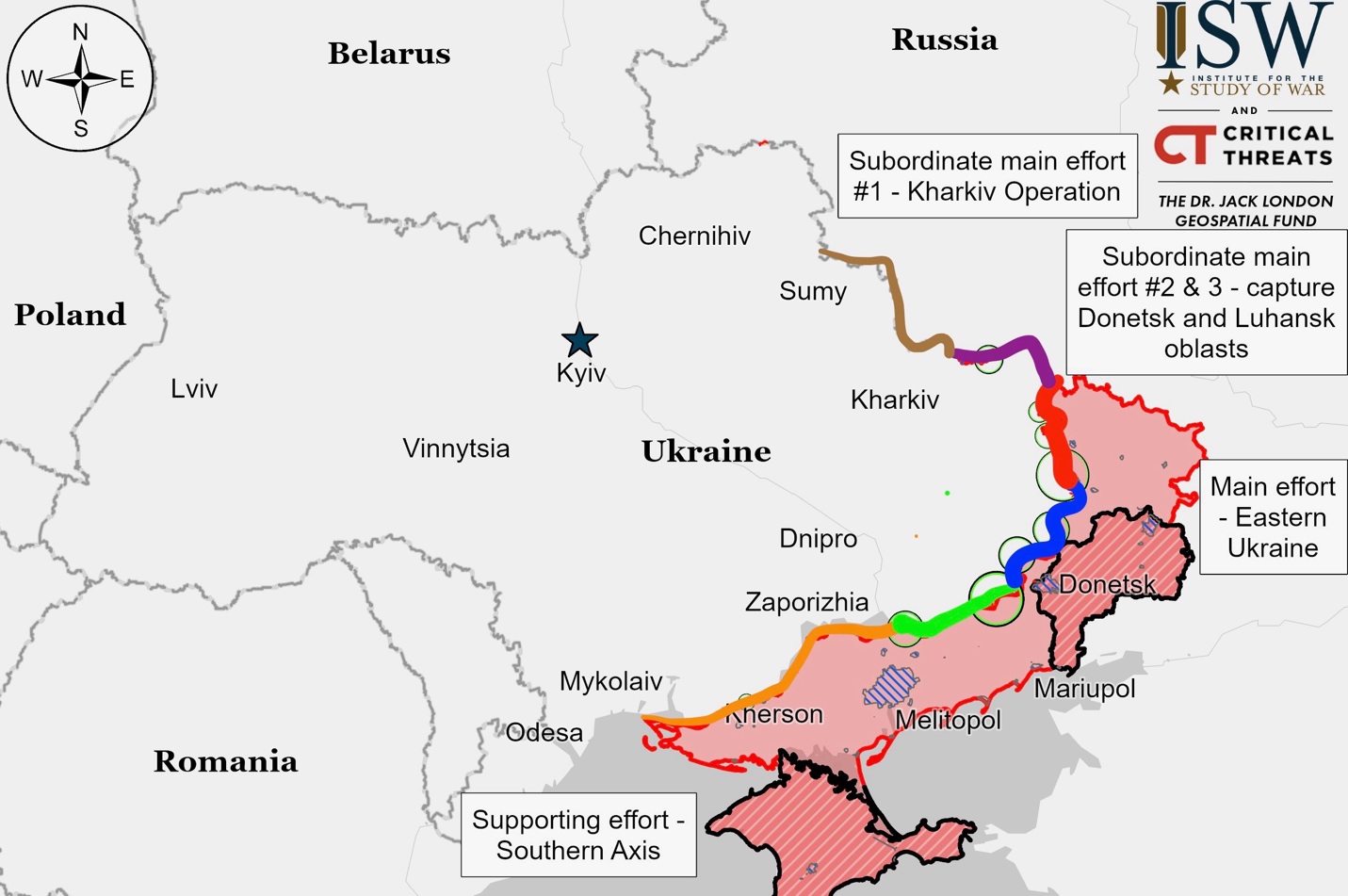
Ukrainian Operations in the Russian Federation – Initiative Russia
Russian forces continued attacks in the Kursk Oblast area, reportedly near several settlements including Sverdlikovo, Sudzha, Guyevo, and Makhnovka. While Russian military bloggers claim advances along the Ivnitsa River and near the 38H-071 highway, these claims remain unverified. Various Russian units, including the Akhmat-Chechnya Regiment and elements of airborne forces, are reportedly conducting drone strikes on Ukrainian positions, particularly near Pogrebki and Sverdlikovo.
Ukrainian forces reportedly conducted a strike on the Novozybkov oil pumping station in Russia’s Bryansk Oblast. Verified footage shows a fire at this Transneft-owned facility, which is part of the Druzhba pipeline that supplies Russian oil to Europe. While multiple sources confirm the fire and attribute it to Ukrainian drones, there are conflicting reports about whether drones or HIMARS missiles were used, and the extent of damage remains unclear.
A suspected Ukrainian drone attack on Russia’s Andreapol oil pumping station has disrupted oil flows through the Ust-Luga port in the Baltic Sea. The port, which normally processes about 650,000 barrels of crude per day (20% of Russia’s seaborne crude supply), showed no oil deliveries on January 29. The attack targeted a station connected to the Baltic Pipeline System-2, operated by Russia’s state-owned Transneft. Ukraine regularly strikes Russian oil facilities to disrupt military fuel supplies and reduce Moscow’s war revenue from energy exports.
Kharkiv Front – Initiative Russia
Ukrainian forces made a small advance in northern Vovchansk, northeast of Kharkiv City, as shown in verified footage. Meanwhile, Russian forces continued their attacks near Kozacha Lopan, a settlement along the Russia-Ukraine border north of Kharkiv City.
Luhansk Front – Initiative Russia
Kupyansk
Russian forces continued attacks near Kupyansk, particularly around Petropavlivka, but made no confirmed advances. While Ukrainian forces reportedly launched counterattacks near Topoli along the Russia-Ukraine border, Russian claims of advances toward Kupyansk’s northern outskirts remain unverified.
Borova
Russian forces attacked multiple settlements near Borova but failed to advance. The attacks focused on areas northeast of Borova (Nova Kruhlyakivka, Lozova, Zahryzove, Kolisnykivka, and Novoosynove), east of Borova (Kopanky), and southeast of Borova (Makiivka, Nevske, and Novoyehorivka).
Lyman
Russian forces attacked several locations in the Lyman area but made no confirmed advances. Their attacks targeted areas north of Lyman (Zelena Dolyna), northeast of Lyman (Kolodyazi, Yampolivka, Terny, and Novolyubivka), and east of Lyman (Torske). While a Russian source claimed success in the Serebryanske forest area, this advance remains unconfirmed.
Donetsk Front – Initiative Russia
Siversk
Russian forces continued attacks near Siversk focusing on Bilohorivka to the northeast and Verkhnokamyanske to the east. While Russian military bloggers claimed advances in both settlements, particularly in eastern Verkhnokamyanske and parts of Bilohorivka, these claims remain unconfirmed.
Chasiv Yar
Russian forces advanced in central Chasiv Yar, specifically along Dniprovska Street, as confirmed by video evidence. Russian sources claim additional advances near several areas including Mykolaivka, along Vysokovoltna Street, and in the Shevchenko and Tsekh No. 2 neighborhoods, though these claims remain unverified. Russian forces also conducted ground attacks near Orikhovo-Vasylivka, Novomarkove, Ozaryanivka, and Predtechyne.
Toretsk
Russian forces advanced in northern Toretsk’s industrial area as confirmed by video evidence. Russian forces attacked near Krymske and Shcherbynivka, though Ukrainian forces report recapturing lost positions near Krymske. A Ukrainian spokesperson noted that their strikes are limiting Russian armored vehicle operations near Toretsk, and that Russian forces are now operating in small units of three to four troops.
Pokrovsk
Ukrainian forces made a small advance west of Novoandriivka (southwest of Pokrovsk) with Ukrainian forces also reportedly counterattacking near Nadiivka. A Ukrainian National Guard spokesperson reported that Russian forces are conducting infantry-only assaults with limited vehicle support, while Ukrainian drones remain their most effective defense. Russian forces continued attacks near multiple settlements including Pokrovsk, Vozdvyzhenka, Malynivka, Lysivka, and several others, though claims of Russian advances near Kotlyne and south of Uspenivka remain unverified.
Kurakhove Region
Russian forces advanced to the eastern outskirts of Andriivka (northwest of Kurakhove). Russian sources claim additional advances into southern Dachne, toward Ulakly from Zelenivka, and southwest of Kostiantynopil, though these claims remain unverified. A Ukrainian drone battalion deputy commander reported that Russian forces are conducting constant ground assaults and attempting to disrupt Ukrainian logistics in the area, with heavy fog limiting drone operations. Russian forces continue attacks near multiple settlements including Andriivka, Shevchenko, Dachne, and Bahatyr.
Velyka Novosilka
Russian forces continued attacks around Velyka Novosilka. While Russian sources claim advances north and northwest of the settlement, these claims remain unverified. Russian forces conducted attacks near several settlements including Novoocheretuvate, Novyi Komar, Rozdolne, and Novosilka. A Russian source claims their forces regrouped after allegedly taking Velyka Novosilka and launched simultaneous attacks near Rozdolne and Andriivka.
Zaporizhia Front – Initiative Russia
Russian forces launched attacks in western Zaporizhia Oblast. They claimed advances near the village of Kamyanske, specifically along Tsentralna Street and the nearby dam area, though these claims remain unverified. Russian drone units are reportedly targeting Ukrainian positions near Orikhiv.
Kherson (Dnipro River) Front – Initiative Russia
Russian forces advanced in the Dnipro area. Video evidence confirms they have captured Velykyi Sokolin Island, which lies southeast of Kherson City.
Ukraine News
Russia launched 81 Shahed drones and decoys from multiple regions including Kursk, Oryol, Rostov, and Krasnodar. Ukrainian forces intercepted 37 drones across ten oblasts. A drone strike on Sumy City killed six people when it hit a residential building. Additional strikes damaged industrial sites and residential areas in Kharkiv, Chernihiv, Odesa, and Poltava regions.
Russian military officials have been charged for a deadly attack on Kharkiv’s Epicenter hypermarket that killed 19 people, including two children, and injured 46 others on May 25. The Ukraine Security Service (SBU) identified five Russian officers responsible: Colonel-General Alexander Lapin ordered the strike while Lieutenant General Valery Solodchuk planned it. Three other officers – Lieutenant General Oleg Makovetsky, Major General Yury Podoplelov, and Colonel Alexey Loboda – were also involved. The attack used Su-34 bombers to launch guided bombs at the civilian target. The proximity of Kharkiv to the Russian border makes it especially vulnerable to such attacks, as Russian aircraft can strike from within their own airspace.
A complex legal battle has emerged in Ukraine’s defense procurement system after Defense Minister Rustem Umerov refused to extend Defense Procurement Agency (DPA) director Maryna Bezrukova’s contract and suspended her, despite the DPA Supervisory Board’s decision to retain her, leading Bezrukova to successfully restore her position in the state register. The conflict, involving the agency which manages over $7 billion in annual defense procurement, deepened when Umerov appointed Arsen Zhumadilov, who also heads the State Rear Operator (DOT), as interim DPA director, with anti-corruption activists claiming this represents an attempted hostile takeover possibly involving the President’s Office Head Andriy Yermak. The situation has disrupted procurement functions and raised concerns about Ukraine’s defense procurement reform and governance standards, prompting G7 ambassadors to call for swift resolution to ensure uninterrupted weapons procurement, while Deputy Prime Minister Olha Stefanishyna announced these issues must be resolved by February’s end, with a special NATO committee meeting scheduled to address the matter, and the National Anti-Corruption Bureau has launched a criminal investigation into Umerov following complaints about the legality of his actions.
A recent Polish poll shows that 50.2% of Poles oppose Ukraine joining NATO and the EU until the Volyn massacre victims’ exhumation issue is resolved. The Volyn massacre, which occurred during World War II, involved the deaths of tens of thousands of Poles by Ukrainian forces, with thousands of Ukrainians killed in retaliation. While Poland has been a key ally of Ukraine during Russia’s invasion, this historical issue has strained relations. A breakthrough occurred in January when both countries approved the first exhumations. The matter has become politically charged ahead of Poland’s presidential election, with candidates divided on whether Ukraine’s NATO and EU membership should be conditional on resolving this historical issue.
Slovakia and Ukraine’s diplomatic relations have deteriorated after Slovak Prime Minister Robert Fico called President Zelensky “the enemy” of Slovakia, leading to reciprocal diplomatic summons between the countries. Tensions escalated after Ukraine terminated Russian gas transit and Zelensky supported anti-Fico protests in Slovakia. Fico’s pro-Russian stance, including threats to limit aid to Ukraine and cut electricity supplies, has sparked concerns about European unity in supporting Ukraine against Russian aggression. The situation threatens regional stability and potentially weakens the unified European response to Russia’s actions in Ukraine, as Slovakia’s alignment with Moscow could encourage other EU members to soften their support for Ukraine.
Ukraine’s Security Service (SBU) announced that a court has frozen assets worth Hr 2.1 billion ($50 million) belonging to Russian oligarch Oleg Deripaska, including 500,000 tons of bauxite and alumina stored at the Mykolaiv Alumina Plant. The materials were intended for Deripaska’s Russian Rusal plants, which reportedly manufacture components for Russian military equipment including Iskander missiles and drones. Deripaska, who was previously Russia’s richest man and remains close to Vladimir Putin, has been charged in absentia with actions aimed at undermining Ukraine’s sovereignty. He has been under various international sanctions since 2018 and has lost both his Cypriot citizenship and control of several Ukrainian business assets.
Nova Poshta, Ukraine’s largest private delivery company, invested Hr 1.8 billion ($43 million) in 2024 to expand its network, adding 1,747 new branches and 8,410 self-service lockers across Ukraine, including 1,214 service points near the front lines in Kharkiv, Dnipro, and Zaporizhzhia oblasts. The company delivered a record 480 million packages in 2024 and has expanded to 16 European countries since Russia’s invasion. Notable developments include Ukraine’s first barrier-free branch in Kyiv and plans to invest Hr 1.2 billion in 2025 for further expansion. The company plays a crucial role in delivering supplies to soldiers and volunteers at the front lines while serving as a vital link for Ukrainians ordering goods from abroad.
Innocent Victims Of War
The casualty count of civilians in the past 24 hours: (Russian War Crimes)
DEATHS: 13 INJURIES: 46
A Russian drone attack on a residential building in Sumy, northeastern Ukraine, killed nine people and injured 13 others. Among the dead were two elderly couples, and the injured included an eight-year-old child. The strike caused substantial damage to the apartment building.
Russian attacks on Kherson Oblast killed three people and injured 10 others, damaging three apartment buildings and 22 houses.
In Donetsk Oblast, multiple Russian attacks struck several cities: Kramatorsk, where 13 people were injured including an 8-year-old boy and a 7-year-old girl; Pokrovsk, where a drone hit an evacuation vehicle, injuring a British volunteer driver and two Ukrainian passengers (aged 42 and 48) with mine-blast trauma and shrapnel wounds, plus two additional injuries in a separate attack; Siversk, where one person was killed; and Bilytske, where two people were injured.
A Russian first-person-view (FPV) drone struck near an ambulance in Kupiansk, Kharkiv Oblast, injuring three medical workers – a 43-year-old driver, a 26-year-old doctor, and a 41-year-old medic.
Russian attacks on the Synelnykove district of Dnipropetrovsk Oblast damaged multiple structures – a school (destroyed), a cultural center, a religious building, an administrative building, a post office, a shop, a company building, and 22 houses, with no casualties reported.
A Russian drone attack on the Izmail district in Odesa Oblast damaged a grain warehouse, a hospital, two houses, and cars, with no casualties reported.
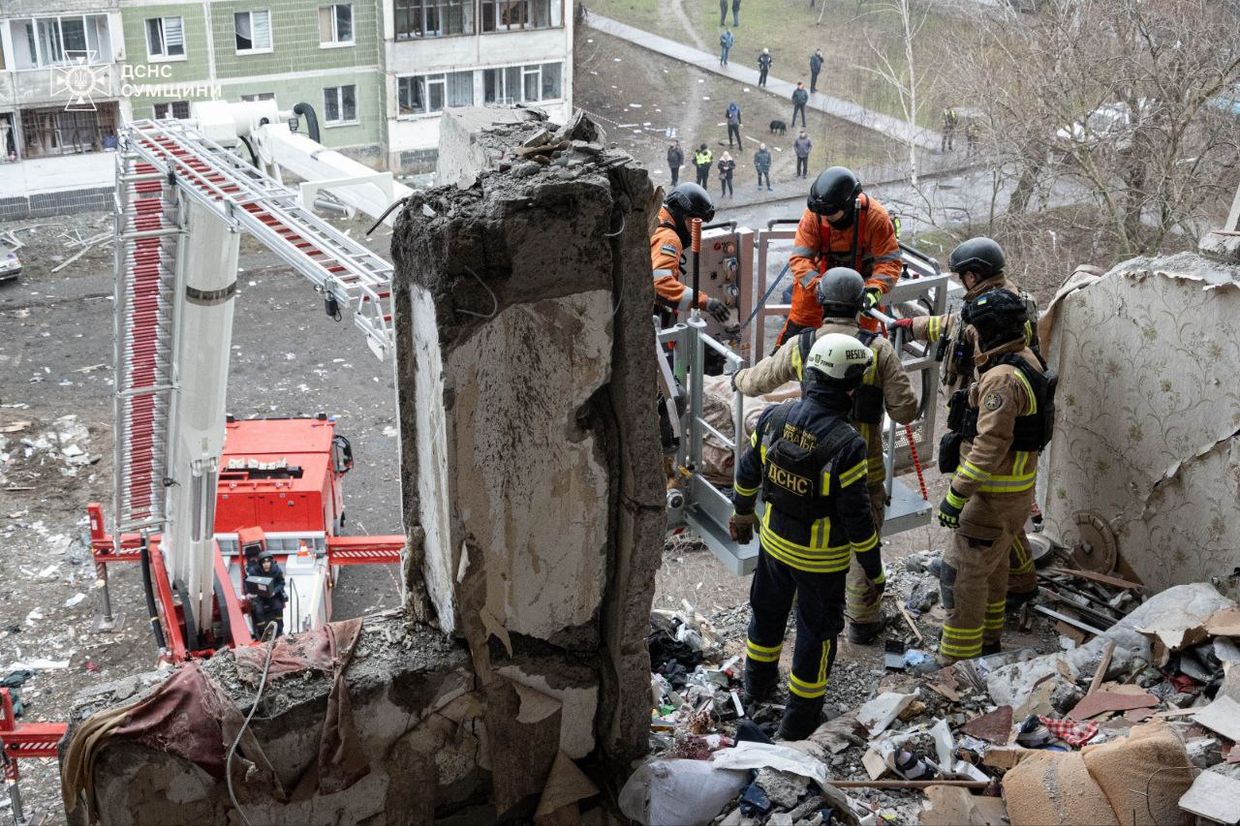 The result of a Russian drone strike on a residential building in Sumy. (Ukraine’s National Police/Telegram)
The result of a Russian drone strike on a residential building in Sumy. (Ukraine’s National Police/Telegram)
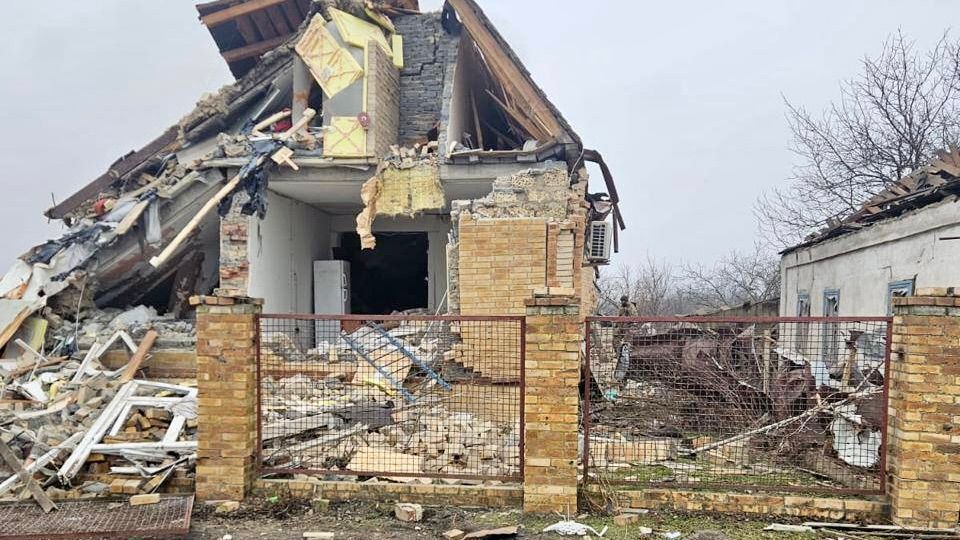 Russian forces attacked civilian infrastructure in Kramatorsk, Donetsk Oblast. (Governor Vadym Filashkin / Facebook)
Russian forces attacked civilian infrastructure in Kramatorsk, Donetsk Oblast. (Governor Vadym Filashkin / Facebook)
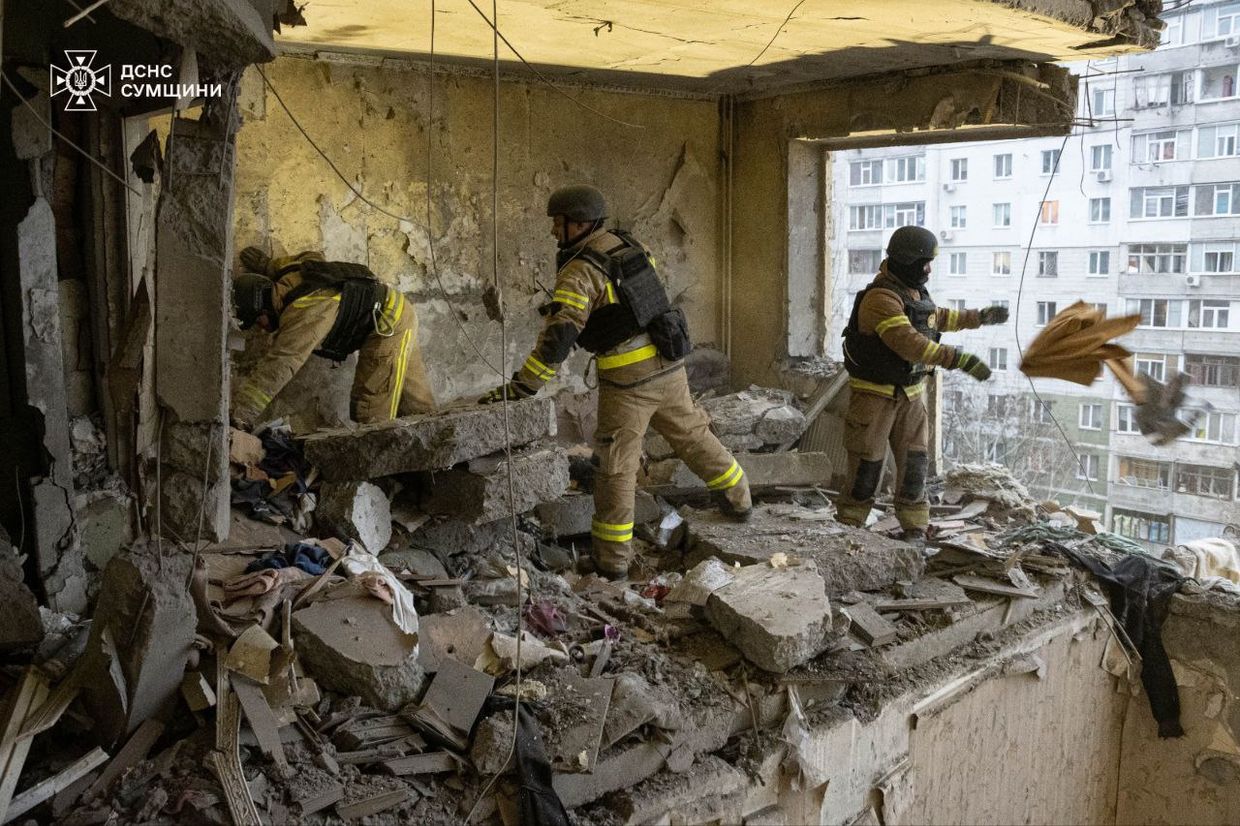 State Emergency Service staff clearing out rubble in an apartment building hit by a Russian drone overnight. (State Emergency Service/Telegram)
State Emergency Service staff clearing out rubble in an apartment building hit by a Russian drone overnight. (State Emergency Service/Telegram)
Ukraine Mobilization and Defense Industrial Base
Ukrainian tech company Huless has secured over $1 million in funding to develop its Highline-T tethered drone system. The drone can operate for up to four hours at heights of 100 meters without GPS, using a cable connection for continuous power and data transmission. Unlike attack drones, the Highline-T functions as a mobile aerial antenna to extend military communications range. The funding, which includes private investment and a grant from Ukraine’s Defense Tech cluster Brave1, will be used to expand market presence and further develop the technology. Digital Transformation Minister Mykhailo Fedorov noted that such Ukrainian defense innovations contribute to both Ukraine’s and NATO’s defense capabilities.
Ukraine’s Allies
The US military has reportedly moved about 90 decommissioned Patriot missiles from storage in Israel to Poland, with plans to transfer them to Ukraine, according to US defense officials.
Sweden announced its largest military aid package to Ukraine since Russia’s 2022 invasion, totaling $1.2 billion. Defense Minister Pal Jonson revealed the package includes combat boats, ammunition, trucks, and anti-tank weapons. The aid combines direct equipment donations with funds for defense production, including missiles and drones. Sweden also allocated money for Ukrainian soldier training and equipment maintenance in 2025.
Russia News
An American Airlines jet carrying 60 passengers, including reported Russian figure skaters, collided with a US Army Black Hawk helicopter over the Potomac River near Washington DC on January 29. The American Eagle Flight 5342 from Wichita, Kansas crashed after the mid-air collision, with former Russian figure skating champions Evgenia Shishkova and Vadim Naumov reportedly among the passengers. The Kremlin confirmed Russian citizens were aboard but didn’t specify names. As of Thursday morning, 18 bodies had been recovered as rescue operations continued.
Russian War Losses (Today/Total)
| Troops +1670 837610 |
Tanks +3 9893 |
Artillery +33 22445 |
Arm. Veh. +17 20631ß |
Aircraft 369 |
Heli 331 |
Ships 28 |
Russia Mobilization and Defense Industrial Base
Russian military officials plan to recruit 126,000 prisoners and individuals under criminal investigation or with outstanding loans to fight in Ukraine, according to Ukraine’s Military Intelligence Directorate. This is part of Russia’s broader goal to recruit 280,000 new personnel in 2025 to maintain its military force levels.
Russian Security Council Secretary Sergei Shoigu inspected 3D printing technology for military equipment and weapons during a visit to the All-Russian Research Institution of Aviation Materials.
The Russian military’s Soviet-era equipment stockpile is severely depleted, with losses exceeding 50% of their total inventory. The remaining combat-ready assets are estimated at 2,000 tanks, 2,000 infantry fighting vehicles, and 3,000 armored personnel carriers, with much of the stored equipment being in poor condition. Russia’s production capacity is limited, producing only 463 BMP-3 vehicles and 300-400 BTR-82 carriers in 2023. Russian assault operations have slowed, with 44% of attacks now focused on the Pokrovsk sector in Donetsk Oblast. Without equipment replenishment, analysts suggest the conflict could diminish by late 2025 or early 2026.
Russia’s Allies
Over two dozen Chinese companies are supplying Russia with critical materials – gallium, germanium, and antimony – used in Russian drones and missiles. These unsanctioned companies are providing materials to Russian defense companies, including state conglomerate Rostec, which produces 80% of Russia’s weapons used in Ukraine. About one-third of these Chinese suppliers have government connections, despite China’s denials of supporting Russia’s war effort. The report also found that a Russian subsidiary of a Japanese company is importing antimony from China and providing silicon wafers to Russian military electronics manufacturers.
Source Material
Institute for the Study of War – understandingwar.org
The Kyiv Independent – kyivindependent.com
Kyiv Post – kyivpost.com
